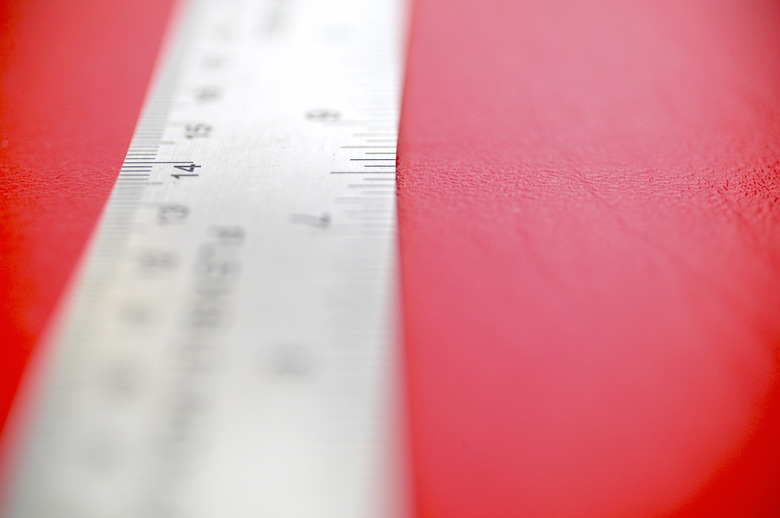How To Read Protein Electrophoresis
We may receive a commission on purchases made from links.
Sodium dodecyl sulphate-polyacrylamide gel electrophoresis (SDS-PAGE) is a biochemical method of identifying proteins in solution. As illustrated by Mathews et al in "Biochemistry," protein samples are first loaded into "wells" or holes on one end of the polyacrylamide gel block. An electrical field is then applied to the gel. SDS, added to the loaded samples, negates the natural charge of proteins. For this reason, protein molecular weight alone determines the migration speed of proteins as they move through the gel toward the positively charged pole, notes Bitesize Bio. Multiple proteins in the same sample will, therefore, separate from each other and migrate to different positions.
Step 1
Orient the gel photograph. "Top" is the location of the wells where the samples were originally added. "Bottom" is where the samples migrated toward and most often contains the dye front that indicates the migrating front of the samples. Either the left or the right should contain a "marker," used as a predictable molecular weight guide.
Step 2
Label the samples for each lane. Across the top, the samples added to the wells will have migrated vertically in "lanes." Therefore, all the bars visible in a vertical column came from the one sample loaded directly above it. Use the ruler and pen to put borders on the lanes if it is difficult to visualize columns.
Step 3
Label the molecular sizes of the bands in the marker lane. Commercially available markers come with a picture of the band pattern to expect along with the molecular weights of each band. Bands are the dark horizonal "bars," which are actually stained protein embedded in the gel.
Step 4
Draw light horizontal lines extending out from each marker band to the opposite edge of the gel. Be careful to make these lines parallel to the wells and to the dye front. These lines indicate where proteins of the molecular weight indicated by each of the marker bands would be located in each lane. For example, a band in lane 4 that resides just below the line extended from the 25-kilodalton marker band would suggest that the lane 4 band is almost but not quite 25 kilodaltons in molecular weight.
Step 5
Label each band in each lane with its estimated molecular weight. Use the markers as a guide, and estimate values between marker sizes.
Step 6
Below the gel photograph, make a list of "proteins" for each lane. Begin by stating what is known about each sample, such as its origin or conditions. Then list the estimated molecular weight of each band in the lane. Lanes with one band indicate that the sample contains only one protein. Lanes with multiple bands indicate the presence of multiple proteins. Bands that run with the migration front are smaller than suggested by the nearest marker and likely cannot be predicted except as "smaller than" the marker indicates.
Step 7
In the proteins list, note oddities. A "smeared" appearance can indicate that too many proteins are present or that the viscosity of the sample affected its migration If bands seem to go beyond the edge of the lane or are quite large compared with other bands, then the concentration of that protein is likely too high and should be diluted in future electrophoresis. A grayish tint throughout the lane, darker than the background gel color, indicates indistinguishable protein fragments.
Step 8
Determine the identity of the proteins in each lane. Although this is done using only molecular weight, the source of each lane will likely indicate clues as well. Consider that under some conditions, proteins can maintain a dimer or trimer association on a gel. Therefore, one protein may appear on a gel as three distinct bands. Even if proteins cannot be identified, the relative darkness of the bands can imply the concentrations of the proteins in solution. Any curious and unknown proteins can be isolated directly from the original gel and sent for identification.
Things Needed
- Photograph of SDS-PAGE gel, stained
- Key for molecular weight marker used
- Ruler
- Pen
Cite This Article
MLA
Tan, Dr. Alex. "How To Read Protein Electrophoresis" sciencing.com, https://www.sciencing.com/read-protein-electrophoresis-5903232/. 24 April 2017.
APA
Tan, Dr. Alex. (2017, April 24). How To Read Protein Electrophoresis. sciencing.com. Retrieved from https://www.sciencing.com/read-protein-electrophoresis-5903232/
Chicago
Tan, Dr. Alex. How To Read Protein Electrophoresis last modified March 24, 2022. https://www.sciencing.com/read-protein-electrophoresis-5903232/
